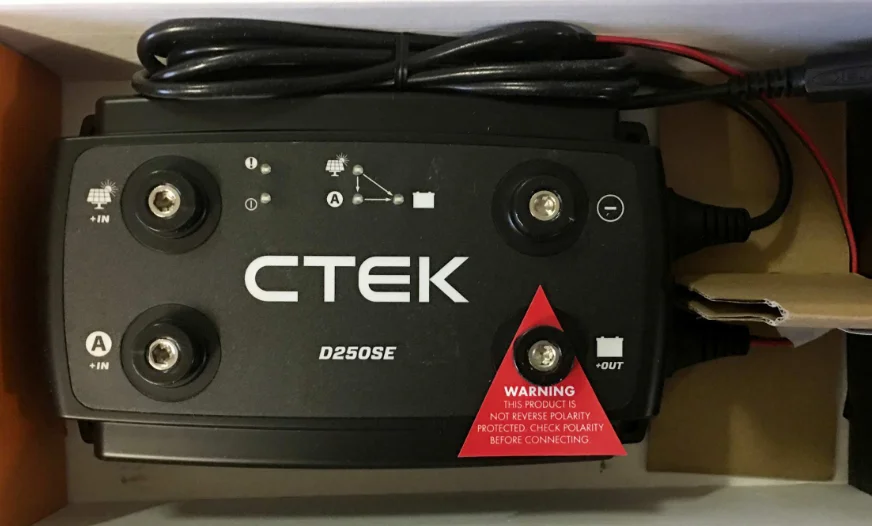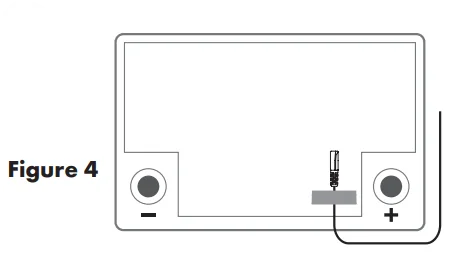
CTEK D250SE 12V DC Battery Charger
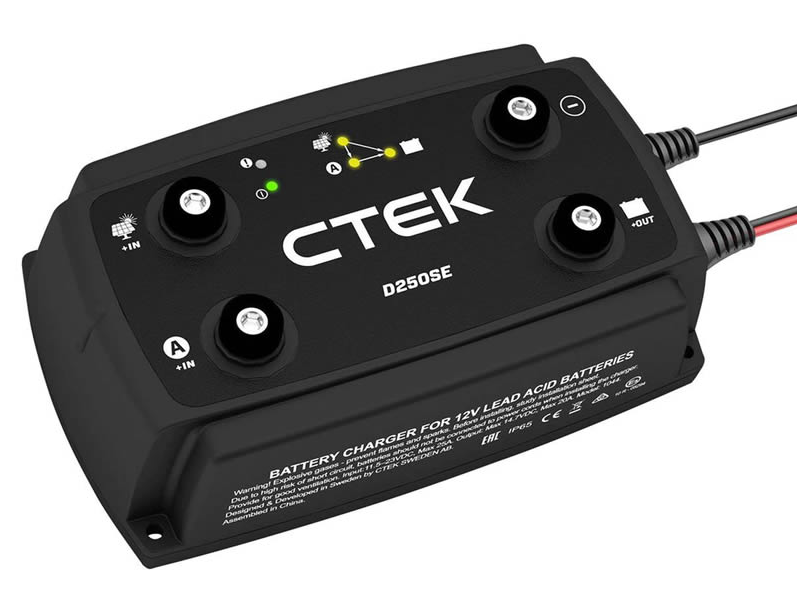
D250SE
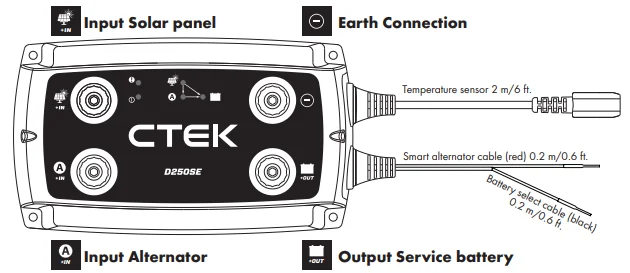
SMARTPASS 120S
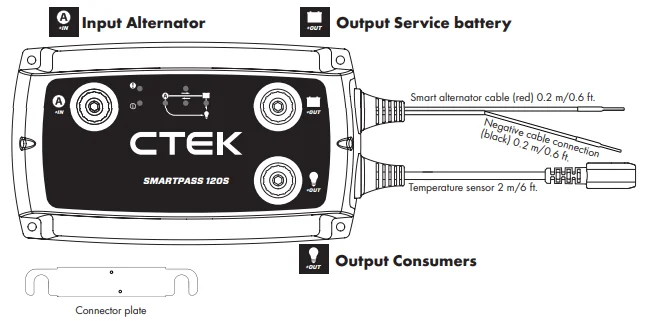
D250SE
- The D250SE is a DC to DC battery charger for a dual battery system with a starter battery and a service battery.
- The D250SE charges the service battery either from an alternator or from a solar panel, or from a combination of both.
- The D250SE separates the batteries in a dual battery system and thereby replaces, for example, a separation relay, VSR (Voltage Sensitive Relay), diode isolator, or a mechanical battery selector.
- The D250SE can be used on its own or in combination with SMARTPASS 120S. In combination, the D250SE and SMARTPASS 120S can charge at up to 140A.
- The starter battery is only available as a lead-acid battery.
FUNCTIONS:
Charging the service battery from a conventional alternator (constant charging voltage)
The D250SE charges a service battery at up to 20A from the start battery when a conventional alternator is running. This function is switched off when the engine is not running to prevent discharge of the starter battery.
Charging of a service battery from a smart alternator (with variable charging voltage)
The D250SE can charge a service battery at up to 20A from the starter battery when a smart alternator is running. This function is switched off when the engine is not running so as not to discharge the starter battery. The Installation section describes how the D250SE needs to be connected in order to activate the smart alternator functions.
Charging a service battery from a solar panel
The D250SE can charge and trickle charge a service battery from a solar panel at up to 20A. The D250SE uses MPPT (Maximum Power Point Tracker) to maximise the power from the solar panel.
Separation of the starter battery and the service battery
The D250SE separates the starter battery from the service battery when the engine is not running.
Temperature-compensated charge voltage
The D250SE optimises the charge voltage by increasing the charge voltage at temperatures below 25°C/77°F and reducing it at temperatures higher than 25°C/77°F. The function is active in AGM and NORMAL programs only.
Trickle charging of the starter battery from a solar panel
The D250SE trickle charges the starter battery from a solar panel at intervals of 3 seconds if the service battery is fully charged.
Optimised charging of AGM batteries
The D250SE can provide a suitable charging voltage for optimal charging of AGM (Absorbent Glass Mat) batteries, which require a higher charge voltage than other types of lead-acid batteries. The installation section describes how the D250SE needs to be connected in order to activate the AGM battery function.
Optimised charging of Lithium batteries
The D250SE can provide a suitable charging voltage for optimal charging of Lithium batteries.
SMARTPASS 120S
- SMARTPASS 120S is a solution for supplying current to charge and manage consumers in a dual battery system consisting of a starter battery and a service battery.
- SMARTPASS 120S separates the batteries in a dual battery system and thereby replaces, for example, a separation relay, VSR (Voltage Sensitive Relay), diode isolator, or a mechanical battery selector.
- SMARTPASS 120S connects the starter and service batteries to charge them both from the alternator.
- SMARTPASS 120S protects the service battery from deep discharge, which would damage the battery.
- SMARTPASS 120S supplies consumers from the alternator instead of from the service battery while the service battery is charging, which permits faster charging.
- SMARTPASS 120S can be used on its own or in combination with D250SE. In combination, the D250SE and SMARTPASS 120S can charge at up to 140A.
FUNCTIONS:
Charging the service battery from a conventional alternator (constant charging voltage)
The SMARTPASS 120S charges a service battery at up to 120A from the start battery when a conventional alternator is running. This function is switched off when the engine is not running to prevent discharge of the starter battery.
Charging of a service battery from a smart alternator (with variable charging voltage)
The SMARTPASS 120S can charge a service battery at up to 120A from the starter battery when a smart alternator is running. This function is switched off when the engine is not running so as not to discharge the starter battery. The Installation section describes how the SMARTPASS 120S needs to be connected in order to activate the smart alternator functions.
Battery guard
SMARTPASS 120S disconnects consumers when the service battery voltage is low in order to avoid deep discharge, which would damage the battery. The consumers are reconnected after the service battery voltage has increased. Connect critical consumers directly to the service battery so they will not be disconnected if the voltage falls lower than 11.5V.
Start assistance
SMARTPASS 120S automatically connects the service battery to the starter battery for 10 seconds to assist if the starter battery on its own is unable to start the engine. After the start assistance function has been activated, SMARTPASS 120S will display a fault indication until starting has been achieved without using the start assistance function.
Separation of the starter battery and the service battery
SMARTPASS 120S separates the starter battery from the service battery when the engine is not running.
Assigning current source priority
SMARTPASS 120S can sense when the alternator is running and, in that case, supplies consumers with current from the starter battery to work with the D250SE and maximise charging efficiency. Otherwise, the consumers are supplied with current from the service battery.
Dynamic overcurrent protection
SMARTPASS 120S has overcurrent protection to shield the product. Overcurrent protection permits up to 350A to be sent from the alternator temporarily so that charging will be accelerated.
Battery temperature protection
SMARTPASS 120S protects the battery by switching off charging if the service battery temperature rises too high.
Starter battery trickle charging
The service battery trickle-charges the starter battery without assistance from the solar panel or alternator to compensate for the self-discharge of the starter battery. The service battery charges in 3-second pulses when its voltage is higher than that of the starter battery and the voltage of the starter battery is low.
CABLE AND FUSE REQUIREMENTS
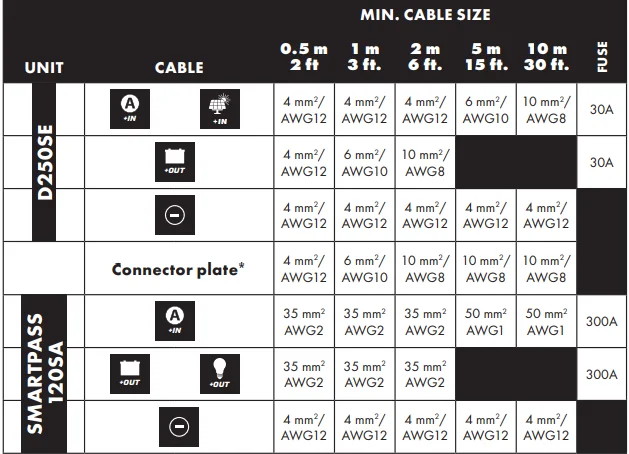
FUNCTION INDICATIONS

INSTALLATION
- Install the apparatus on a smooth surface where it can be firmly secured and where it is not exposed to fuel, oil, or dirt. To obtain the correct distance, start by fitting the two units together with the accompanying connector plate (see Figure 3) before they are finally fastened to the smooth surface.
- Secure the apparatus with, for example, M4 or ST4.2 screws at each corner (see Figure 1).
- Before connecting the cables, ensure that the negative terminal post on the battery is not connected.
- Connect the cables to the apparatus connections by securing screws (M8) (see Figure 2). Use an Allen key – tightening by hand without a tool is not enough. Max 6 mm ring terminals (see Figure 5).
- Use tape (see Figure 4) to secure the temperature sensor to a clean flat surface above the service battery. Position the sensor as close to the positive terminal post as possible.
- Connect the battery negative terminal post.

RECOMMENDED TIGHTENING TORQUES
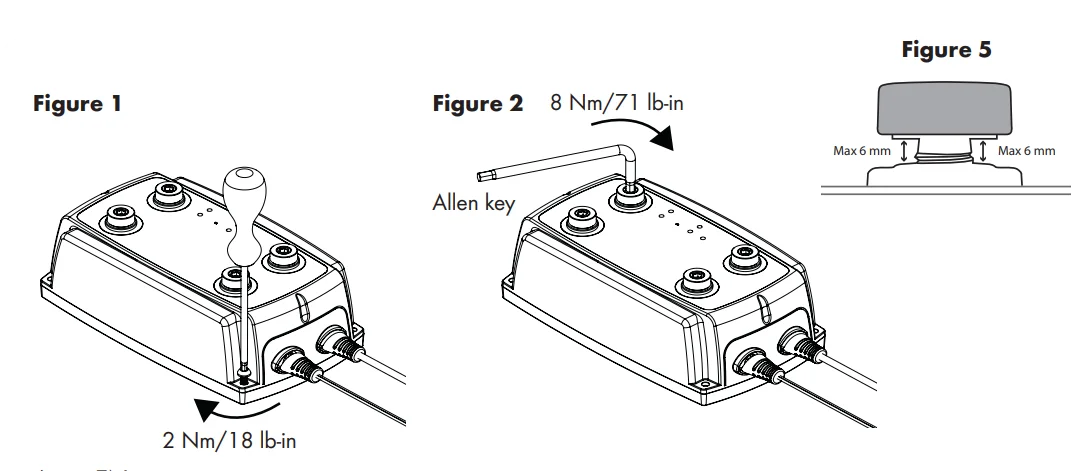
DIMENSIONS


SETTINGS D250SE
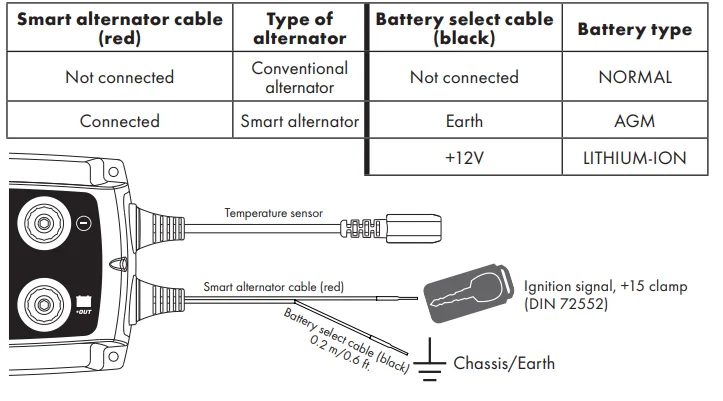
SETTINGS SMARTPASS 120S
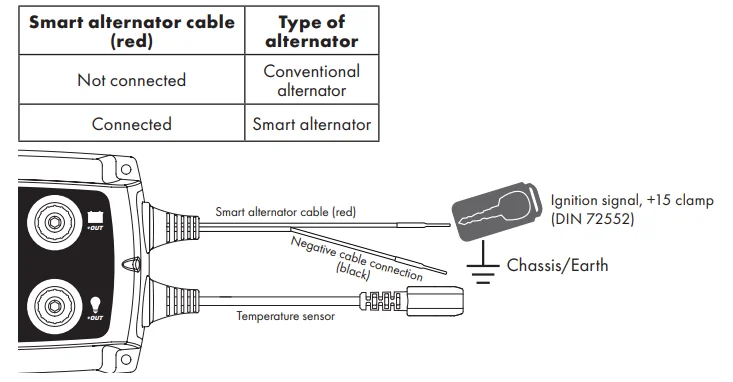
INSTALLATION EXAMPLES
1. Solar panel
PREREQUISITES
Solar panel capable of charging a 40–300Ah service battery. The D250SE uses MPPT (Maximum Power Point Tracker) to maximise the power from a solar panel.
TIP 1
Do not connect two solar panels in series. Max input voltage 23V.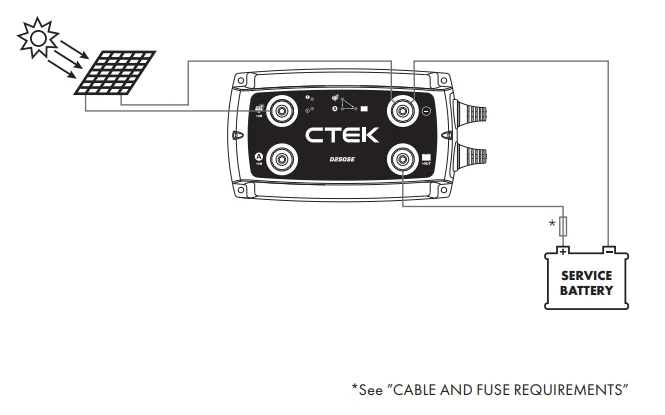
2. Small service battery
PREREQUISITES
- A dual battery system where the D250SE charges a 40–300Ah service battery from a generator, which also charges a starter battery. It is advantageous to use this installation when:
- The alternator is unable to deliver the desired charging voltage.
TIP 2
If the alternator has external voltage detection for the service battery, the voltage detection wiring must be connected to the starter battery.
TIP 3
Complement the D250SE with a SMARTPASS 120S if the service battery capacity is greater than 100Ah or has parallel consumption while charging is in progress. This reduces the charging time.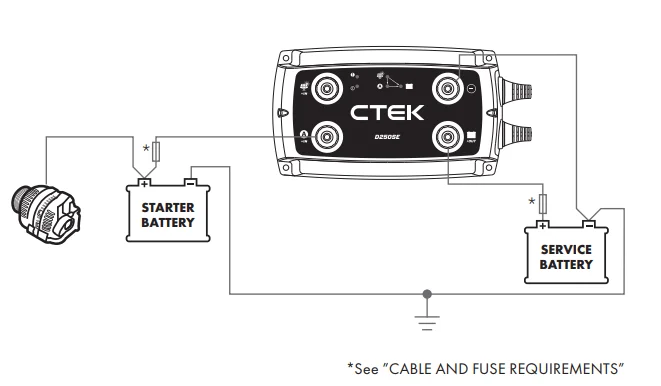
3. Small service battery and solar panel
PREREQUISITES
A dual battery system where the D250SE charges a 40–300Ah service battery from a solar panel, an alternator, or both, which also charges a starter battery. It is advantageous to use this installation when:
- The alternator is not able to deliver the desired charge voltage.
- Charging from a solar panel.
- See also tips 1, 2, and 3.

4. Service battery with parallel consumers
PREREQUISITES
A dual battery system where the SMARTPASS 120S charges a 28–800Ah service battery from an alternator, which also charges a starter battery. It is advantageous to use this installation when:
- The alternator can deliver the desired charging voltage.
- The service battery capacity is greater than 100Ah.
- The consumers are supplied directly from the alternator at the same time as the service battery is being charged.
- See also tips 2 and 3.

5. Large service battery with parallel consumers
PREREQUISITES
A dual battery system where a D250SE, together with a SMARTPASS 120S, charges a 100–800Ah service battery. Current is supplied from a solar panel and/or an alternator. The starter battery is charged from an alternator. It is advantageous to use this installation when:
- The alternator is not able to deliver the desired charging voltage.
- The service battery capacity is greater than 100Ah.
Parallel consumption takes place during charging. By connecting the consumers (see TECHNICAL SPECIFICATION) to the Output Consumers on the SMARTPASS 120S, the service battery will be able to charge without parallel consumption, and the consumers will instead be supplied with current from the alternator. - The service battery shall be protected against deep discharge. Connect noncritical consumers to the Output Consumers on the SMARTPASS 120S. Connect critical consumers directly to the service battery. SMARTPASS 120S does not switch off the critical consumers in that case when the service battery is completely discharged.
TIP 4
Connect the cabling from the starter and service batteries, respectively, to the SMARTPASS 120S and not to the D250SE. See also tips 1, 2, and 3.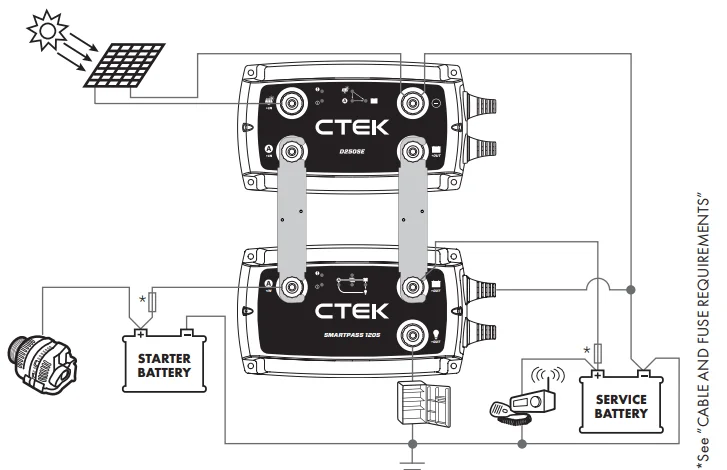
6. Connect an AC/DC charger
PREREQUISITES
A dual battery system where there is a 230/110V charger and a D250SE that, together with a SMARTPASS 120S, charges a service battery with a capacity of 150–800Ah. Current is supplied from a solar panel and/or an alternator to the service battery. The starter battery is charged from an alternator. It is advantageous to use this installation when:
- The charge from the alternator while it is charging (engine running) is not enough, so it has to be supplemented by a 230/110V charger.
- The alternator is not able to deliver the desired charge voltage.
- The service battery capacity is greater than 150Ah.
- Parallel consumption while charging is taking place. By connecting the consumers (see TECHNICAL SPECIFICATION) to the Output Consumers on the SMARTPASS 120S, the service battery will be able to charge without parallel consumption, and the consumers will instead be supplied with current from the alternator.
TIP 5
Connect a 230/110V charger to the starter battery if it needs charging. In that case, both the starter and service batteries will be optimally charged from the 230/110V charger.
TIP 6
Heavy current consumers (see TECHNICAL SPECIFICATION) must be connected directly to the service or starter battery. See also tips 1, 2, 3, and 4.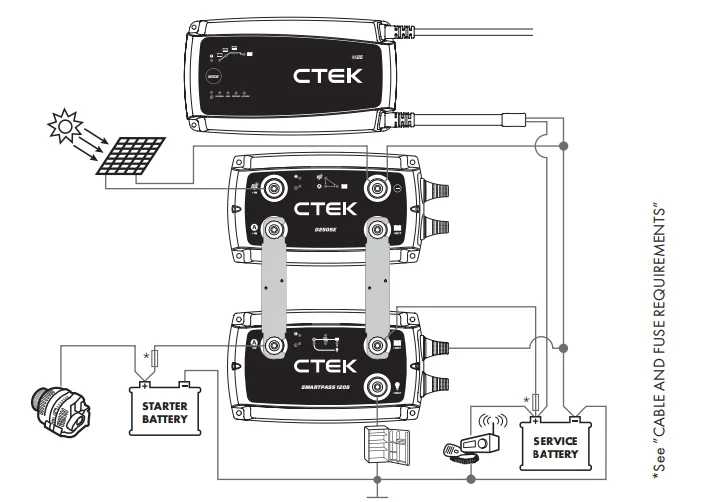
D250SE CHARGING PROGRAM LEAD-ACID
STEP 1 DESULPHATION
Detects sulphated batteries. Pulsing current and voltage remove sulphate from the lead plates of the battery, restoring the battery capacity.
STEP 2 BULK
Charging with maximum current until approximately 80% battery capacity.
STEP 3 ABSORPTION
Charging with a declining current to maximize up to 100% battery capacity.
STEP 4 FLOAT
Maintaining the battery voltage at the maximum level by providing a constant voltage charge.
STEP 5 PULSE
Maintaining the battery at 95–100% capacity. The charger monitors the battery voltage and gives a pulse when necessary to keep the battery fully charged.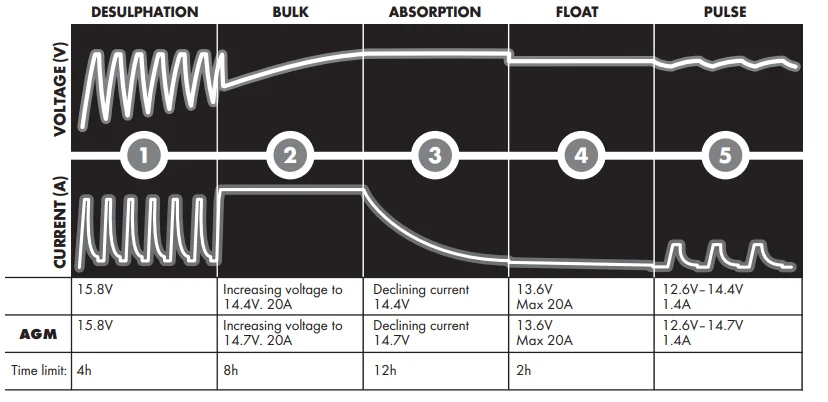
D250SE CHARGING PROGRAM LITHIUM
STEP 1 ACCEPT
Tests if the battery can accept a charge. This step prevents charging from proceeding with a defective battery.
STEP 2 BULK
Charging with maximum current until approximately 90% battery capacity.
STEP 3 ABSORPTION
Charging with a declining current to maximize up to 95% battery capacity.
STEP 4 FLOAT
Maintaining the battery voltage at the maximum level by providing a constant voltage charge.
STEP 5 PULSE
Maintaining the battery at 95–100% capacity. The charger monitors the battery voltage and gives a pulse when necessary to keep the battery fully charged.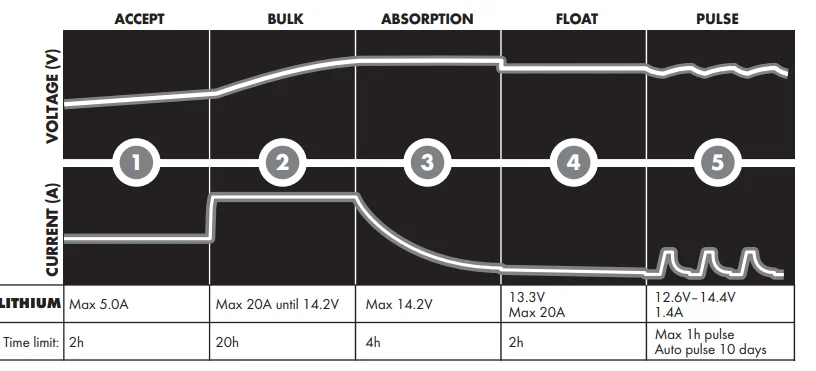
TECHNICAL SPECIFICATION
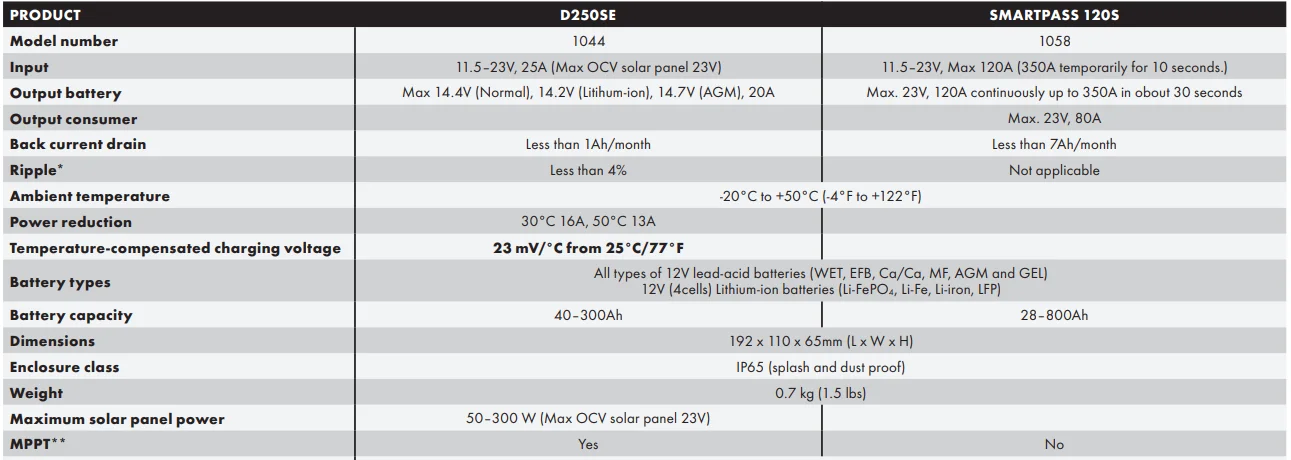

- The quality of the charge voltage and charge current is very important. A high current ripple heats up the battery, which has an aging effect on the positive electrode. High voltage ripple could harm other equipment that is connected to the battery. CTEK battery chargers produce very clean voltage and current with low ripple.
- MPPT (Maximum Power Point Tracker) finds the best combination of current and voltage so that the output power is maximised.
LIMITED WARRANTY
CTEK issues this limited warranty to the original purchaser of this product. This limited warranty is not transferable. The warranty applies to manufacturing faults and material defects. The customer must return the product, together with the receipt of purchase, to the point of purchase. This warranty is void if the product has been opened, handled carelessly, or repaired by anyone other than CTEK or its authorised representatives.
One of the screw holes in the bottom of the product may be sealed. Removing or damaging the seal will void the warranty. CTEK makes no warranty other than this limited warranty and is not liable for any other costs other than those mentioned above, i.e., no consequential damages. Moreover, CTEK is not obligated to any warranty other than this warranty.
SUPPORT
Visit www.ctek.com for support, FAQ, the most recent version of the user instructions, and further information concerning CTEK products.
For More Manuals By CTEK, Visit ManualsLibraryy.
CTEK D250SE 12V DC Battery Charger-FAQs
How do I use the CTEK D250SE charger?
Simply connect the input cables to your alternator or solar panel, and the output cables to your service battery. Once connected, the charger automatically detects the battery type and starts charging using the correct profile.
What’s the difference between the CTEK D250SA and D250SE?
The D250SE improves on the older D250SA model by adding a lithium battery charge profile and enhanced MPPT solar charging for faster, more efficient charging performance.
Can the CTEK D250SE charge lithium batteries?
Yes. The D250SE supports both lead-acid and lithium (LiFePO₄) batteries. You can select the lithium charge mode for safe and optimized performance.
Can I leave my CTEK charger connected all the time?
Yes. The D250SE can safely remain connected. It automatically switches to maintenance mode once the battery is fully charged, preventing overcharging or damage.
How long does it take to charge a 100Ah battery with a 250W solar panel?
Under ideal sunlight, a 250W solar panel can charge a 100Ah battery in about 5–6 hours using the CTEK D250SE’s MPPT solar input.
Can the D250SE drain the main vehicle battery?
No. Once the battery reaches full charge, the D250SE automatically switches to float maintenance mode, preventing overcharging and battery stress.
How do I know when my battery is fully charged?
When the green LED indicator is lit on the charger, it means the battery has reached full charge and is now being maintained.
Is CTEK a Chinese company?
No. CTEK is a Swedish company known for designing high-quality, smart charging solutions and accessories for vehicles and boats.

